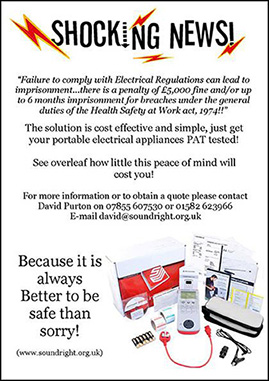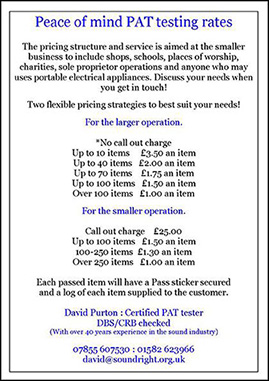Reviews
Read what some of the leading reviewers said about some of
David’s designs!
the amount of low bass energy
this speaker can produce is astounding..
is up there with the
established big boys, ATC, Genelec, PMC and the rest..
Hugh Robjohns
..an optional, I would
suggest imperative extra is on site analysis and alignment of the
system..
the
results were most impressive, exhibiting delicacy and presence
conveying the subtle detail..that few boxed loudspeakers can equal
Ivor Humphreys
"there
was absolutely no hint of either compression or distortion, just
limitless power coupled with lightning speed"
David Allcock
Other Links
Peter Mapp article
and others, Look here.

PAT (Portable Appliance Testing) testing is not a legal requirement in the UK but it is a legal requirement to ensure the electrical safety of all your portable electrical appliances. (The Electricity at Work Regulations, 1989).
These include everything that is not “ bolted down”! PC’s, laptops, printers, scanners, copiers, kettles, microwaves, every mains lead, extension leads, drills & maintenance tools...to the vacuum cleaners your staff or contractors may use!
Your Public liability and indemnity insurance is likely to be invalid without PAT Test safety certificates.
The Sound Right operation includes consultation and advising on audio equipment and it’s implementation and installation. Offering PAT testing across the full range of portable electrical appliances you may use in your workplace was obviously compatible the Sound Right range of services.
You will be pleasantly surprised at the competitive prices and you should contact David for a quote for the testing you require.
Sound Right offers a fully comprehensive PAT testing operation.
- All Class 1 and Class 2 Electrical Appliances & IT
- Calibrated PAT tester with certificate of accuracy
- Full readings, not just “Pass” or “Fail”!
- Earth Continuity, Insulation Resistance & Mains Socket testing
- Cable and extension lead testing up to 30 m in length
- Microwave emission testing
- Qualified Operator! link to certificate
- Full detailed log supplied to you for your data base
Better safe than sorry, call David at Sound Right to find out what it may cost for peace of mind!
Contact : 07855 607530 ~ 01582 623966 or e mail: david@soundright.org.uk
Read these two recent reports, make sure this is not you!
"Landlord breached electrical safety rules"
A Lincolnshire landlord faces a £5,000 penalty in fines and court costs after failing to keep three bedsit houses he manages in a safe and suitable condition, a court has ruled.
The landlord pleaded guilty to nine offences of failing to meet regulations relating to the management of houses in multiple occupancy in the town. He was given fines of £2,800, a victim surcharge of £75 and must meet North Kesteven District Council’s prosecution costs following multiple complaints from tenants about the condition and safety of the properties in Sleaford.
The breaches related to failure to provide electrical safety certificates on each house, not having fire alarms tested, not having a hand rail in one house, inadequate lighting in two of them and a locked front door which could not be opened from the inside in the event of a fire – all factors which the magistrates described as significant safety issues.”
"Electrical faults contribute to fire risks"
Fire Statistics Great Britain continue to report faulty appliances and leads as the dominant cause of accidental fires in non-residential buildings.
In the figures for 2013-2014, there were 22,200 fires recorded in buildings that were not dwellings. The majority of these fires occurred in private garages and sheds (21%), shops (13%), industrial premises (11%) and restaurants, cafes pubs and bars (10%).
Of these fires, about 75% were regarded as accidental. The main cause was faulty appliances and leads which was said to be responsible for around 3,700 fires, down by 5% from
2012-2013.
Another key cause of accidental fires in other buildings was the misuse of equipment or appliances which accounted for 2,200 fires and was down by 8% from one year earlier.”
 |
 |